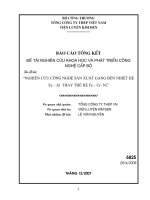Redox student part4 pourbaix diagrams fe
Bạn đang xem bản rút gọn của tài liệu. Xem và tải ngay bản đầy đủ của tài liệu tại đây (1.06 MB, 27 trang )
Pourbaix diagrams
Plots of E vs pH
We will, as an example, derive the Pourbaix diagram for iron
Two Latimer diagrams pertain
In acid ([H+] = 1 M):
Fe3+
0.77 V
-0.44 V
Fe(OH)2
Fe
In alkali ([OH-] = 1 M)
-0.56 V
Fe3+
-0.887 V
Fe(OH)2
Fe
Pourbaix diagrams:
•correlate Latimer diagrams at pH 0 and pH 14
•take into account speciation or oxidation state of the element
Fe3+
0.77 V
-0.44 V
Fe(OH)2
The half reaction
Fe3+ + e → Fe2+
Eo = 0.77 V
does not involve a proton so Eo is independent of pH
Fe
Fe3+ + e → Fe2+
Fe3+ will precipitate out of solution as pH is increased. We can calculate the pH
at which this will occur from the KSP for Fe(OH)3.
Fe(OH)3(s) Ý Fe3+ + 3OH–
KSP = 4.11 x 10-37 M4
At what pH will [Fe3+] = 1.00 M?
KSP = 4.11 x 10-37 M4 = [Fe3+][OH–]3
[OH–] = (4.11 x 10-37/1)0.333
= 7.43 x 10-13 M
So [H+] = 10-14/7.43 x 10-13 = 1.35 x 10-2 M
hence pH = 1.87
Fe(OH)3 Ý Fe3+ + 3OH-
Vertical lines in a Pourbaix
diagram indicate where two
species of an element in the
same oxidation state are in
equilibrium
To calculate the
Fe(OH)3|Fe2+
line...
Fe3+ + e → Fe2+
Eo = 0.77 V
3OH- + 3H+ → 3H2O
∆Go = -74.3 kJ mol-1
-239.7 kJ mol-1
Fe(OH)3 → Fe3+ + 3OHFe(OH)3 + 3H+ + e → Fe2+ + 3H2O
207.6 kJ mol-1
∆Go = -nFEo
-106.4
kJ mol-1
= -1 x 96485
x 0.77
∆Go = -RT ln KSP
= -8.315 x 298 x ln (4.11 x 10-37)
∆Go = -nFEo
Eo = -∆Go /nF
= 106400/1 x 96485
= 1.10 V
Fe(OH)3 + 3H+ + e → Fe2+ + 3H2O
Eo = 1.10 V
E = Eo – RT/nF ln Q
E = 1.10 – 3 x 0.0592 x pH
This must cross the Fe3+/Fe(OH)3 line when
0.77 = 1.10 – 3(0.0592)pH
or pH = 1.87
which confirms the result we got from the KSP calclation
Fe3+
0.77 V
-0.44 V
Fe(OH)2
Fe
1.1
Fe(OH)3 + 3H+ + e → Fe2+ + 3H2O
1.1
Fe(OH)3 + 3H+ + e → Fe2+ + 3H2O
From the KSP for Fe(OH)2
Fe(OH)2 Ý Fe2+ + 2OH–
KSP = 1.61 x 10-15 M3
At what pH will [Fe2+] = 1.00 M?
KSP = 1.61 x 10-15 M3 = [Fe2+][OH–]2
[OH–] = (1.61 x 10-15/1)0.5
= 4.01 x 10-8 M
So [H+] = 10-14/4.01 x 10-8 = 2.49 x 10-7 M
hence pH = 6.61
1.1
Fe(OH)2 Ý Fe2+ + 2OH-
The half reaction
Fe2+ + 2e → Fe
Eo = -0.44 V
does not involve a proton so Eo is independent of pH
1.1
Fe2+ + 2e → Fe
An expression for the potential for the Fe(OH)3|Fe(OH)2 couple can be derived
from the following data
Fe(OH)3 + 3H+ + e → Fe2+ + 2H2O
Eo 1.10 V
∆Go -106.4 kJ mol-1
3H2O → 3H+ + 3OH-
239.7 kJ mol-1
Fe2+ + 2OH- → Fe(OH)2
-84.4 kJ mol-1
Fe(OH)3 + e → Fe(OH)2 + OH-
Eo -0.51 V
∆Go 48.9 kJ mol-1
E = Eo – RT/nF ln Q
E = -0.51 + 0.0592 x pOH
E = -0.51 + 0.0592 x (14 – pH)
E = 0.316 – 0.0592 x pH
1.1
0.316
Fe(OH)3 + e → Fe(OH)2 + OH-
...and finally the value of Fe(OH)2|Fe couple can be found by
similar considerations, and the Nernst equation applied.
E = -0.060 – 0.0592 x pH
Overlaying Pourbaix diagrams
The feasibility of a reaction can be predicted by overlaying the relevant
Pourbaix diagrams
stability field for As(V)
stability field for As(III)
At pH < 5.5 and at
pH > 9, Fe3+ has the
potential to oxidise
As3+ to As5+
5.5
9
For example
0.65
0.45
Fe(OH)3 + e + 3H+ → Fe2+ + 3H2O
E = 0.65
2
As3+ → As5+ + 2e
E = -0.45
As3+ + 2Fe(OH)3 + 6H+ → 2Fe2+ + 6H2O + As5+ E = 0.20 V
For 5.5 < pH < 9
As5+ will oxidise Fe2+
to Fe3+
The effect of complex formation on Eo values
The Eo value of a metal ion is very dependent on the ligands of the ion
Example, for the Fe3+|Fe2+ couple
Ligand
phenanthroline
H2O
CN-
Eo /V
1.14
0.77
0.36
Ligand
phenanthroline
H2O
CN-
N
N
N
N
N
N
N
Fe
Fe
N
N
N
π back bonding from
metal to phen ligand
stabilises Fe(II)
Eo /V
1.14
0.77
0.36









